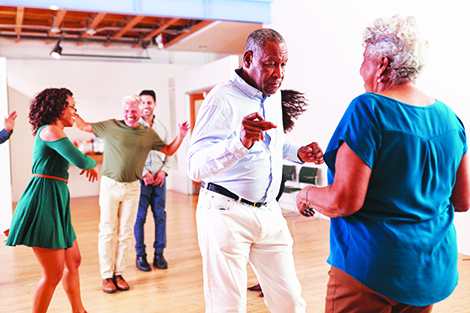Life requires balance, agility, and dexterity — think staying stable on ice or playing your favorite sport.
Life requires functional fitness — think carrying groceries or shoveling snow.
Life requires mobility — think bending down to pick up a golf ball, getting up and down from the floor, or turning your head while driving.
Basically, life requires you to be dynamic, strong, and subtle. Training exclusively on stable weight machines and repetitive cardio equipment just doesn’t cut it. Life is not predictable. Stop training as if it is. You’re not a robot. Don’t train like one.
To stay vital, strong, balanced, coordinated, agile and injury-free, prioritize single-leg activities, dynamic motions, multi-joint strength exercises, and interval training.
Single-leg exercises.
Single-leg exercises train the body to balance and provide feedback to the brain about the body’s position in space. Try standing on one leg. Once that is easy, close your eyes and/or do a single-leg hinge: Stand on your right leg, chest out. Hinge forward, keeping your back flat. Keep your left hip down toward the floor as you hinge your chest forward. Use your right bum muscles to stand up. Repeat five or more times. Switch legs.
Multi-directional motions.
As we age, the body typically becomes less subtle; we lose the ability to easily rotate, bend, step, or lean sideways and react with multi-directional movements. This lack of agility not only feels terrible, but it can contribute to injuries from doing simple tasks like rotating to get something from the backseat or reaching for something awkwardly placed.
The solution? Try activities such as dancing, sports that require multi-directional motion like tennis, and multi-directional strength exercises such as side lunges. For side lunges, step your right leg sideways. Sit backward into the right leg as if the right side of your bum is squatting into a chair. Keep your left leg straight. Keep your chest out and shoulders back. Engage your right bum muscles to power you back up to standing.
Multi-joint strength exercises.
Strength training increases lean muscle mass, helps to decrease the risk of osteoporosis, maintains the integrity of joints, and mitigates decreases in bone and muscle mass. The squat is, in my opinion, the most fundamental strength exercise. Maintaining the ability — both the strength and the mobility — to squat is imperative. We squat innumerable times every day. Think about it. You squat to go to the bathroom, to sit down and get up, to get in and out of the car, and even into bed. It’s almost impossible to function if you can’t squat, but to produce the movement pattern, you need hip, knee and ankle mobility, as well as lower-body and core strength. Including squats as a non-negotiable part of your workout routine helps maintain this mobility and strength.
Tips on squatting: Start with your feet hip-distance apart. Bend at your knees, hips and ankles so that you sit backward — as if you were sitting in a chair. As you sit, imagine your sit bones widening at the back. Watch your knees — make sure they track over your middle toes. Engage your bum and core to stand up.
Interval training.
Interval training improves cardiovascular health, places a high metabolic demand on the body, burns lots of calories in a short amount of time, produces a high EPOC (post-workout calorie burn), increases mitochondrial growth (mitochondria help to burn fat), and helps improve one’s fitness level.
On any cardio machine, try rolling intervals. Once warmed up, alternate one minute easy, one minute moderate, and one minute hard for nine to 15 minutes. If you don’t have or like cardio machines, try jumping rope or high-intensity body-weight cardio exercises such as burpees or jumping jacks.
Too many of us take our bodies for granted. We assume we will be able to effortlessly do tomorrow what we can do today, or we see our bodies as they were 10 years ago rather than how they are now. Like it or not, bodies change with time. With age, our muscle and bone mass, metabolism, mobility, stamina, and strength naturally decrease — unless we make a conscious effort to mitigate the changes. Don’t put off to tomorrow what you can do today. Start now! If you like other forms of exercise, by all means do what you love; but make sure you also include single-leg activities, multi-directional motions, multi-joint strength exercises, and intervals in your regimen.
Kathleen Trotter (kathleentrotter.com), who wrote this article, is a fitness expert, nutrition and life coach, and author of two books, including her most recent (“Your Fittest Future Selfâ€).
